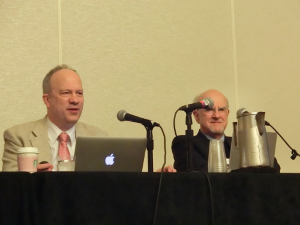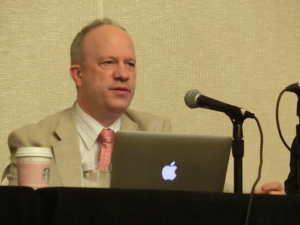News
チャード教授がIJASを代表してAASで報告
3月24日フィラデルフィアで開催されたAssociation for Asian Studies年次大会でパネル 'Getting Published in Asian Studies: the Significance of New Open Access Mandates' において International Journal of Asian Studiesを代表してチャード教授が報告をしました。
現在公金に依存した研究成果についてOPEN ACCESSであるべきだとの流れが強くなってきており、ダウンロードに課金する現行の学術誌システムは見直しが迫られています。IJASの出版元であるケンブリッジ大学出版会はすでに課金制度と無料アクセスを合わせた混合型を志向しているようで、当面IJASのあり方に大きな影響はなさそうです。
パネルの写真とチャード教授の報告を添付します。
Association for Asian Studies, Philadelphia, 2014
Panel 98, ‘Getting Published in Asian Studies: the Significance of New Open Access Mandates’
26 March 2014
This panel, organized by Paul Kratoska (NUS Press, Singapore, and Regional Editor for IJAS), continued and expanded themes discussed at the ICAS Macau conference in June 2013, with specific emphasis on how funding body mandates requiring Open Access publication of research they fund have affected journals and other academic publications in Asian Studies. The participants were: Paul Kratoska (Chair); Michael Duckworth, head of the University of Hawai‘i Press; Robert Chard, Managing Editor of IJAS, Institute for Advanced Studies on Asia at the University of Tokyo; and Charles Fosselman, Stanford University East Asia Library. Following is a summary of the issues covered, based on the information and opinions included in the panel presentations, and on discussion from the audience.
Government and private funding bodies in America and Europe began several years ago to mandate that the results of all research they fund be published in open access form, that is freely accessible to the public to read without paying subscription or other charges. Compliance with such mandates entails either the payment of an Article Preparation Charge (APC) to an academic journal by the author, with the article then available to anyone to download at no cost (the ‘Gold’ model), or that the author place a version of the article that is the same as, or very close to, the final version in an online institutional repository which is available to anyone to download (the ‘Green’ model). Embargo periods may also apply, under which the publication is available only on a pay basis for a specified period of time, anywhere from six months to two years or more.
Open Access mandates have the potential to bring about substantial changes to academic journal publication, where high subscription charges have been the norm. In the sciences these have already made themselves felt, with the payment of Article Preparation Charges now quite common. In the Humanities, Open Access mandates have been imposed more recently. It is not yet clear what effect they will have on Asian Studies disciplines, and although most would agree that free access to academic publications is a good thing in principle, there is concern that there might be negative as well as positive consequences.
Under the Green model, for example, institutional repositories have been set up haphazardly and are poorly managed, to the extent that in some cases academics are not aware of the existence of such repositories in their own institutions at all. Often the material in repositories is difficult to access, since it has not been indexed using standard forms of metadata, so that it cannot be found even through searches in the same institution’s library system, much less from the outside. Another issue is that some researchers, particular younger ones, are unwilling for their PhD dissertations and other work to be placed in a repository, for fear that this will make it difficult for them to publish the same work elsewhere, owing to publishers’ reluctance to publish material which is already available without charge from another source. Some also worry that work placed in electronic archives can be easily copied and plagiarized.
Concerns have also been raised about the Gold model. Authors must find funding to pay the APCs, which places a burden both upon them and their institutions. Less well-funded institutions may not be able to cover APCs for all their staff, who might then not be able to publish in top journals. Decisions on APC funding allocation within institutions might be made by university administrators, meaning that decisions on which articles to publish will be made by non-specialists rather than by journal editors and referees. This situation looks increasingly likely in the UK: starting in April 2013 the research councils have eliminated funding for APCs in individual grants, and instead now make block grants to institutions for this, and the institutions must decide how to allocate these.
Another concern with the Gold model is that it does not alleviate the financial burden borne by institutions for library subscriptions, but merely shifts it to APC costs, and if anything compounds the burden during the transition to Open Access, when the institution may pay both subscription costs and APCs to the same publishers at the same time. This in effect would penalize research, since costs would fall disproportionately on research universities. And, recent statistics suggest that the same commercial academic publishers who profit most from high subscription charges are also the ones who earn the most from APCs: in 2012–13 the Wellcome Trust paid more to Elsevier than to any other publisher, both in total (US$1.65 million out of $6.5 million, or 25%), and per published work ($4000+).
The availability of APCs has also led to the growth of ‘predatory’ journals and publishers, newly-created operations, often with perfunctory or non-existent evaluation procedures, who offer quick online publication and collect APCs. Such dubious publishers are exposed by the online Beall's List of Predatory Publishers.
What is the potential effect of Open Access mandates on IJAS? Over the medium term at least, there is unlikely to be any real change to the current arrangement with Cambridge University Press. Cambridge has already responded to the Open Access mandates by introducing a new separate copyright agreement for those wishing to pay an APC (currently US$ 2700) and make their article Open Access. All Cambridge journals (including IJAS) are therefore hybrid journals, able to publish both traditional and Open Access content in the same issue. From January 2014, IJAS carries a notice on the inside back cover notifying contributors of this option, but so far there have been no inquiries about it. It is also worth noting that the standard Cambridge copyright agreement gives authors considerable leeway in disseminating their publications to others, which in most cases makes possible compliance with mandates on the Green model.
In short, as far as IJAS is concerned, Open Access poses no threat, and its circulation with Cambridge continues to grow.
Robert Chard
2/4/2014
登録種別:研究活動記録
登録日時:FriApr418:24:062014
登録者 :チャード・黒田・藤岡
掲載期間:20140324 - 20140624
当日期間:20140324 - 20140324



